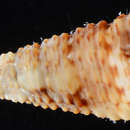Comprehensive Description
provided by Smithsonian Contributions to Zoology
Cerithium interstriatum Sowerby, 1855
Cerithium interstriatum Sowerby, 1855:876–877, pl. 184: fig. 216 [lectotype, herein selected: BMNH 10971028112; no locality given, Honolulu. Hawaii, herein selected as type locality; 13 mm × 5mm]; 1865, pl. 14: fig. 93.—Kay, 1979:122, fig. 451.
Cerithium clavis Sowerby, 1865, pl 14: fig. 94 [lectotype, herein selected: BMNH. 19861691, 15.9 mm × 4.8 mm; 1 paralectotype 19861692; no locality].—Kobelt. 1898:227, pl. 40: fig. 5.—Schepman, 1909:161–162.— Kay. 1979:122.
Cerithium thaanumi Pilsbry and Vanatta, 1905:576; 1906:787, fig. 1 [holotype: ANSP 85855; type locality: Hilo, Hawaii, 14.2 mm × 4.5 mm].
DESCRIPTION.—Shell (Figure 64A–G, I–M): Shell elongate, slender, small, reaching 16.6 mm length and 5.4 mm width, and comprising 11–14 weakly inflated whorls sculptured with 3 spiral weakly beaded cords. Protoconch (Figure 64F) comprising 3.5 whorls; protoconch I smooth, one whorl; protoconch II sculptured with subsutural plications and two spiral cords, papillate on final whorl; sinusigeral notch in aperture lip of protoconch II. Early teleoconch (Figure 64I) whorls cancellate due to axial ribs crossing spirals. Teleoconch whorls sculptured with 3 or 4 major, beaded, spiral cords, thin spiral, subsutural cord, and with thin spiral thread between major spiral cords; 22–28, weak beads on spiral cords forming colabral axial ribs. Varices randomly distributed. Suture moderately impressed. Upper and mid-teleoconch whorls with 27 or 28 strong beads. Body whorl (Figure 64K) long, sculptured with 5 major, weakly papillate, beaded, spirals and smooth interstriae, and large varix opposite outer lip of aperture. Base of body whorl weakly excavated with moderate siphonal constriction and sculptured with fine spiral striae. Aperture round, small, about one–fifth the shell length. Columella strongly concave with distinct callus. Anterior canal short, tubular and sharply reflected upwards and to left of shell axis. Outer lip of aperture thin, strongly convex, and weakly crenulate. Small anal canal present flanked by tiny parietal columellar tooth. Shell color white to cream, rarely brown, with irregular light tan blotches and tiny spiral, tan spots on cords. Aperture white. Measurements (Table 23). Periostracum not evident. Operculum (Figure 64H) thin, tan, corneous, subcircular, multispiral around nearly central nucleus, becoming paucispiral later.
Radula (Figure 65): Type-4 radular ribbon (Figure 3D) short, about one–fourteenth the shell length. Rachidian tooth (Figure 65B) having thin posterior longitudinal ridge and short, median, triangular, posterior extension on flat, rectangular, basal plate; cutting edge with sharp triangular main cusp, flanked with 2 or 3 small denticles. Lateral tooth (Figure 65B) with strong central ridge and long lateral, posterior extension on basal plate. Large, triangular main cusp flanked by one inner denticle and 3 or 4 small, outer denticles. Marginal teeth (Figure 65A,B) with moderately broad central shafts, broad bases and pointed, serrated apices with sharp cusp at tips. Inner marginal tooth with 4 inner flanking denticles and 3 outer flanking denticles. Outer marginal tooth same, but lacking outer flanking denticles.
Anatomy: Head-foot white-cream color. Snout with pair of brown double bands and white bilobed tip. Long cephalic tentacles pink, striped with tan, each bearing small black eye on tentacular peduncle. Wide mantle edge fringed with small papillae overhanging snout.
Large, wide osphradium. Ctenidium with long, triangular, feather-like filaments. Pair of large, long jaws (0.5 mm in shell 17 mm long) comprised of scale-like elements. Salivary glands comprised of paired, thin, convoluted tubes originating behind and passing through nerve ring, lying mostly anterior to it. Weak esophageal gland present.
Nervous system tightly organized with supraesophageal ganglion close to right pleural ganglion.
SYNONYMIC
- bibliographic citation
- Houbrick, Richard S. 1992. "Monograph of the genus Cerithium Bruguiere in the Indo-Pacific (Cerithiidae: Prosobranchia)." Smithsonian Contributions to Zoology. 1-211. https://doi.org/10.5479/si.00810282.510
Cerithium interstriatum: Brief Summary
provided by wikipedia EN
Cerithium interstriatum is a species of sea snail, a marine gastropod mollusk in the family Cerithiidae.
- license
- cc-by-sa-3.0
- copyright
- Wikipedia authors and editors

